
Horn speaker
Encyclopedia

Loudspeaker
A loudspeaker is an electroacoustic transducer that produces sound in response to an electrical audio signal input. Non-electrical loudspeakers were developed as accessories to telephone systems, but electronic amplification by vacuum tube made loudspeakers more generally useful...
or loudspeaker element which uses a horn
Horn (acoustic)
A horn is a tapered sound guide designed to provide an acoustic impedance match between a sound source and free air. This has the effect of maximizing the efficiency with which sound waves from the particular source are transferred to the air...
to increase the overall efficiency of the driving element, typically a diaphragm driven by an electromagnet. The horn itself is a passive component and does not amplify the sound from the driving element as such, but rather improves the coupling efficiency between the speaker driver
Speaker driver
A speaker driver is an individual transducer that converts electrical energy to sound waves, typically as part of a loudspeaker, television, or other electronics device. Sometimes the transducer is itself referred to as a speaker, particularly when a single one is mounted in an enclosure or as...
and the air. The horn can be thought of as an "acoustic transformer
Transformer
A transformer is a device that transfers electrical energy from one circuit to another through inductively coupled conductors—the transformer's coils. A varying current in the first or primary winding creates a varying magnetic flux in the transformer's core and thus a varying magnetic field...
" that provides impedance matching
Impedance matching
In electronics, impedance matching is the practice of designing the input impedance of an electrical load to maximize the power transfer and/or minimize reflections from the load....
between the relatively dense diaphragm material and the air of low density
Density
The mass density or density of a material is defined as its mass per unit volume. The symbol most often used for density is ρ . In some cases , density is also defined as its weight per unit volume; although, this quantity is more properly called specific weight...
. The result is greater acoustic output from a given driver.
The narrow part of the horn next to the speaker driver is called the "throat" and the large part farthest away from the speaker driver is called the "mouth".
Horns have been used to extend the low frequency limit of a speaker driver—when mated to a horn, a speaker driver is able to reproduce lower tones more strongly. The flare rate and the mouth size determine the low frequency limit. The throat size is more of a design choice. Horns have been known to extend the frequency range of a driver beyond five octaves.
Horns have been used to modify the directional characteristics of the produced sound waves. Horizontal coverage angle is the primary determinant of horn width, and vertical coverage angle determines horn height. On- and off-axis performance will differ depending on the shape of the horn. Compromises in performance such as distortions of the wavefront must be balanced against the design goal.
Operation
Acoustic horns convert large pressure variations with a small displacement area into a low pressure variation with a large displacement area and vice versa. It does this through the gradual, often exponentialExponential growth
Exponential growth occurs when the growth rate of a mathematical function is proportional to the function's current value...
increase of the cross sectional area of the horn. The small cross-sectional area of the throat restricts the passage of air thus presenting a high impedance to the driver. This allows the driver to develop a high pressure for a given displacement. Therefore the sound waves at the throat are of high pressure and low displacement. The tapered shape of the horn allows the sound waves to gradually decompress and increase in displacement until they reach the mouth where they are of a low pressure but large displacement.
A modern electrically driven horn loudspeaker works the same way, replacing the mechanically excited diaphragm with a dynamic or piezoelectric loudspeaker.
Modern horn designs typically feature some form of conical, exponential or tractrix
Tractrix
Tractrix is the curve along which a small object moves, under the influence of friction, when pulled on a horizontal plane by a piece of thread and a puller that moves at a right angle to the initial line between the object and the puller at an infinitesimal speed. It is therefore a curve of...
taper
Taper
In cymbal making, taper refers to the gradual change in thickness from the bell to the rim of the cymbal. It is one of the key features that determines the tone of the cymbal....
. Roughly speaking, the slower the flare rate, the deeper and lower frequencies the horn will reproduce for a given length of horn. For example, a horn area growth rate of 30% per foot will allow reproduction down to about 30 Hz
Hertz
The hertz is the SI unit of frequency defined as the number of cycles per second of a periodic phenomenon. One of its most common uses is the description of the sine wave, particularly those used in radio and audio applications....
; 10 times area per foot provides midrange reproduction; 100 times area per foot is used in high frequency horns.
Modern high output horns also make the throat area of the horn smaller than the cone diaphragm area. This is called the "loading" or "compression" ratio of the horn. The compression ratio is the cone area divided by the throat area. Typically for bass and midrange frequency the compression ratio is from (1.5 to 1) low compression to normal compression (2 to 1) to high compression (3.5 to 1). High frequency compression drivers sometimes have compression ratios as high as 10 to 1.
The higher the compression the greater the horn's ability to properly couple the diaphragm to the air at the horn's mouth, increasing efficiency, until the compression ratio is so high that it actually begins to impede cone motion. At this point the maximum sound output power from the horn (at a given distortion) will be reduced. To demonstrate this at an extreme, place a cone woofer
Woofer
Woofer is the term commonly used for a loudspeaker driver designed to produce low frequency sounds, typically from around 40 hertz up to about a kilohertz or higher. The name is from the onomatopoeic English word for a dog's bark, "woof"...
face down on a concrete floor. The compression ratio will be very high, however sound output from the back of the speaker will be quite low.
Horn technology history
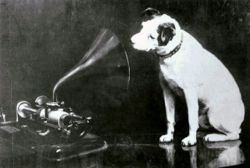
Phonograph
The phonograph record player, or gramophone is a device introduced in 1877 that has had continued common use for reproducing sound recordings, although when first developed, the phonograph was used to both record and reproduce sounds...
s, where the record moved a heavy metal needle that excited vibrations in a small metal diaphragm
Diaphragm (acoustics)
In the field of acoustics, a diaphragm is a transducer intended to faithfully inter-convert mechanical motion and sound. It is commonly constructed of a thin membrane or sheet of various materials. The varying air pressure of the sound waves imparts vibrations onto the diaphragm which can then be...
that acted as the driver for a horn. A famous example was the horn through which Nipper
Nipper
Nipper was a dog that served as the model for a painting titled His Late Master's Voice. This image was the basis for the dog and trumpet logo used by several audio recording and associated brands: His Master's Voice, HMV, RCA, Victor Talking Machine Company, RCA Victor and JVC.- Biography :Nipper...
the RCA
RCA
RCA Corporation, founded as the Radio Corporation of America, was an American electronics company in existence from 1919 to 1986. The RCA trademark is currently owned by the French conglomerate Technicolor SA through RCA Trademark Management S.A., a company owned by Technicolor...
dog heard "His Master's Voice". The horn improves the loading and thus gets a better "coupling" of energy from the diaphragm into the air, and the pressure variations therefore get smaller as the volume expands and the sound travels up the horn. This kind of mechanical impedance matching was absolutely necessary in the days of pre-electrical sound reproduction in order to achieve a usable sound level.
Cone
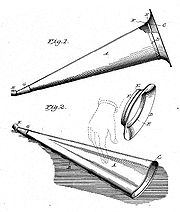
Cone (geometry)
A cone is an n-dimensional geometric shape that tapers smoothly from a base to a point called the apex or vertex. Formally, it is the solid figure formed by the locus of all straight line segments that join the apex to the base...
is the oldest and simplest acoustic horn and, as the megaphone
Megaphone
A megaphone, speaking-trumpet, bullhorn, blowhorn, or loud hailer is a portable, usually hand-held, cone-shaped horn used to amplify a person’s voice or other sounds towards a targeted direction. This is accomplished by channelling the sound through the megaphone, which also serves to match the...
, is still used by cheerleaders and lifeguards as a passive amplifier of their voices. Because the conic section shape describes a portion of a perfect sphere of radiated sound, cones have no phase or amplitude distortion of the wavefront. The acoustic loading provided by the cone does not extend the low frequency limit low enough for most modern purposes, with its output energy markedly less than later designs throughout the bottom two octaves of the cone's intended frequency range.
Exponential
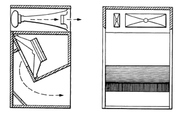
Exponential function
In mathematics, the exponential function is the function ex, where e is the number such that the function ex is its own derivative. The exponential function is used to model a relationship in which a constant change in the independent variable gives the same proportional change In mathematics,...
horn has an acoustic loading property that allows the speaker driver to remain evenly balanced in output level over its frequency range. The benefits of the design were first published by C.R. Hanna and J. Slepian in 1924 for the American Institute of Electrical Engineers
American Institute of Electrical Engineers
The American Institute of Electrical Engineers was a United States based organization of electrical engineers that existed between 1884 and 1963, when it merged with the Institute of Radio Engineers to form the Institute of Electrical and Electronics Engineers .- History :The 1884 founders of the...
(AIEE). A major drawback is that the exponential horn allows for a narrowing of the radiation pattern as frequency increases, making for high frequency 'beaming' on axis and dull sound off axis. Another concern is that a throat of small diameter is needed for high efficiency at high frequencies but a larger throat is best for low frequencies. A common solution is to use two or more horns, each with the appropriate throat size, mouth size and flare rate for best performance in a selected frequency range, with sufficient overlap between the frequency ranges to provide a smooth transition between horns. Another solution tried in the late 1930s by Harry F. Olson
Harry F. Olson
Harry Ferdinand Olson was a prominent engineer at RCA Victor.Harry F. Olson, a pioneer in the field of 20th century acoustical engineering, was born in Mount Pleasant, Iowa to Swedish immigrant parents...
of RCA
RCA
RCA Corporation, founded as the Radio Corporation of America, was an American electronics company in existence from 1919 to 1986. The RCA trademark is currently owned by the French conglomerate Technicolor SA through RCA Trademark Management S.A., a company owned by Technicolor...
was to use multiple exponential flare rates, either by connecting increasingly larger horns in series or by subdividing the interior of a single horn. Exponential horns continue to be used by some designers, and in some applications.
Multicell
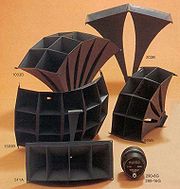
Western Electric
Western Electric Company was an American electrical engineering company, the manufacturing arm of AT&T from 1881 to 1995. It was the scene of a number of technological innovations and also some seminal developments in industrial management...
, multicell horns have been used in loudspeakers since 1933 to address the problem of directivity at higher frequencies, and they provide excellent low frequency loading. Their directional control begins to beam both vertically and horizontally in the middle of their target frequency range, narrowing further at high frequencies with level changes as great as between lobes. Multicell horns are complex, difficult to fabricate and thus have a higher associated expense. They persisted in public address
Public address
A public address system is an electronic amplification system with a mixer, amplifier and loudspeakers, used to reinforce a sound source, e.g., a person giving a speech, a DJ playing prerecorded music, and distributing the sound throughout a venue or building.Simple PA systems are often used in...
applications for many years because, even with their faults, they sounded relatively good. The revolutionary coaxial driver, the Altec Duplex 601 and 604, used a multicell horn for its high frequency component from 1943 to 1998.
Radial, sectoral and diffraction
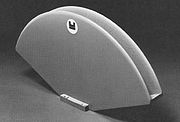
JBL
JBL is an American audio electronics company currently owned by Harman International. It was founded in 1946 by James Bullough Lansing. Their primary products are loudspeakers and associated electronics. There are two independent divisions within the company — JBL Consumer and JBL Professional...
's diffraction or "Smith" horn was a variation on the radial design, using a very small vertical dimension at the mouth as a method of avoiding the mid-range horizontal beaming of radial horns that have a larger vertical dimension at the mouth. The diffraction horn has been popular in monitor designs and for near-field public address applications which benefit from its wide horizontal dispersion pattern. Counterintuitively, the narrow vertical dimension provided for an expansive vertical output pattern approaching 90° for frequencies of a wavelength equal to the narrow vertical dimension. A very small version of the diffraction horn was designed in 1991 into the JBL model 2405H Ultra-High Frequency Transducer, yielding a 90° x 35° output pattern at .
Tractrix
The tractrixTractrix
Tractrix is the curve along which a small object moves, under the influence of friction, when pulled on a horizontal plane by a piece of thread and a puller that moves at a right angle to the initial line between the object and the puller at an infinitesimal speed. It is therefore a curve of...
horn is very similar in many respects to the exponential horn and has gained adherents among DIY
Do it yourself
Do it yourself is a term used to describe building, modifying, or repairing of something without the aid of experts or professionals...
horn enthusiasts and audiophile
Audiophile
An audiophile is a person who enjoys listening to recorded music, usually in a home. Some audiophiles are more interested in collecting and listening to music, while others are more interested in collecting and listening to audio components, whose "sound quality" they consider as important as the...
consumers. It uses a curve formula derived by assuming that a tangent to any point on the horn's inner curve will reach the central axis of the horn with a line segment of set length. At the mouth, the tangent line segment becomes perpendicular to the axis and describes the radius of the mouth. This horn concept was studied by Paul G.A.H. Voigt in the mid-1920s and patented in 1927. The size of the tractrix horn is generated by specifying the desired low frequency "cutoff" or limit which will determine the mouth diameter. Two incremental improvements over the exponential horn include slightly better support for low frequency extension and a somewhat broader high-frequency coverage pattern.
Constant directivity
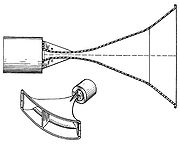
Electro-Voice
Electro-Voice is a manufacturer of audio equipment, including microphones, amplifiers, and loudspeakers. A subdivision of Telex Communications Inc., Electro-Voice markets its products for use in small or large concert venues, broadcasting, houses of worship, and in retail situations.-History:On...
introduced a hybrid horn with an exponential expansion rate near the throat followed by a conical expansion section and ending with a rapidly flaring flange at the mouth. The flange at the mouth solved some remaining problems with lobing at higher frequencies. Don Keele specified in one version of his design a wider horizontal flare for pattern control appropriate to public address purposes. Keele's paper set forth the relationships between mouth size, frequency and coverage angle, providing a basis for many future developments of horn design. One problem found with constant directivity horns is that the horizontal coverage pattern can't be narrowed without making the vertical coverage pattern too small to be useful.
Mantaray
Subsequent to Keele's work and using his principles, Clifford A. Henricksen and Mark S. Ureda of Altec designed a strikingly different hybrid horn displaying constant directivity traits, the horizontal diffraction or "Mantaray" horn. The Mantaray separated desired vertical coverage pattern from horizontal, making it possible to design horns for a variety of coverage patterns. The Mantaray shape starts with a vertically-oriented JBL-style diffraction horn leading into a conical waveguide (earliest designs) or a square or rectangular horn with four planar sides. For midrange beaming control, the outer mouth was expanded further with a short, flared flange in the Keele style, or with added planar sides of a greater flare angle. Low frequency efficiency wasn't as pronounced as the constant directivity design. Unlike previous designs, the apparent apex, the focal point of pattern dispersion, was not the same for every frequency, making for an ellipsoidal wavefront rather than spherical. Because of this, the Mantaray could only be arrayed satisfactorily in one plane. Its abrupt breaks in flare rate caused diffraction, reflection and distortion components.Bi-Radial
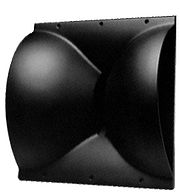
Twin Bessel
Ramsa, the professional audioProfessional audio
Professional audio, also 'pro audio', refers to both an activity and a type of audio equipment. Typically it encompasses the production or reproduction of sound for an audience, by individuals who do such work as an occupation like live event support, using sound reinforcement systems designed for...
division of Panasonic Corporation, introduced a twin Bessel constant directivity horn shortly after the Mantaray appeared. The design was very similar to the Mantaray and the Bi-Radial but it used a dual series Bessel expansion formula to determine the flare rate of the secondary horn section.
CD horn characteristics
Most popular constant directivity horns (also known as CD horns) suffer from non-spherical wavefronts, limitations in arrayability, distortion at high sound pressureSound pressure
Sound pressure or acoustic pressure is the local pressure deviation from the ambient atmospheric pressure caused by a sound wave. Sound pressure can be measured using a microphone in air and a hydrophone in water...
levels as well as reflections and distortions related to the transition from diffraction slot to secondary horn. They tend toward a narrowing of dispersion pattern at the higher frequencies whose wavelengths approach the width of the throat or the width of the diffraction slot.
Because the CD horn's high frequencies are more spread out over its coverage pattern, they appear attenuated relative to other horns. The CD horn requires an equalization
Equalization
Equalization, is the process of adjusting the balance between frequency components within an electronic signal. The most well known use of equalization is in sound recording and reproduction but there are many other applications in electronics and telecommunications. The circuit or equipment used...
boost of approximately per octave with a filter knee centered between 2 and (depending on horn design) in order to sound neutral and balanced. Most manufacturers of active electronic audio crossover
Audio crossover
Audio crossovers are a class of electronic filter used in audio applications. Most individual loudspeaker drivers are incapable of covering the entire audio spectrum from low frequencies to high frequencies with acceptable relative volume and lack of distortion so most hi-fi speaker systems use a...
s responded to this requirement by adding an optional CD EQ boost filter or high frequency shelf filter. For instance, such circuitry was provided via internal jumper links by BSS in their FDS-310 crossover and by Rane
Rane Corp.
Rane Corporation is a pro audio equipment manufacturer. Located in Mukilteo, Washington, it was made up of former employees of Phase Linear Corporation, and started out with products aimed at small live bands...
in their AC 22S and AC 23B crossovers. Rane allowed for greater front panel control of two bandpasses ("hi-mid" and "high") using CD horn equalization including sweepable frequency range on their AC 24 crossover. Further refinements of the filtering process are available in DSP
Digital signal processor
A digital signal processor is a specialized microprocessor with an architecture optimized for the fast operational needs of digital signal processing.-Typical characteristics:...
-based crossovers.
Multiple entry horn
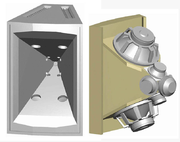
Renkus-Heinz
Renkus-Heinz is a manufacturer of loudspeakers and related professional sound reinforcement equipment. Based in Foothill Ranch, California, the firm has a global presence in permanent installations at auditoriums, transit centers,, sports venues, houses of worship and musical performance venues as...
received a patent for a multiple entry horn which incorporated multiple drivers for two bandpasses, high and mid, whose sound waves all exited into a single horn but at differing distances depending on the bandpass. It was marketed as the "CoEntrant" horn. The mid- and high-frequency drivers in the Renkus-Heinz ST/STX product line both exited through a "Complex Conic" waveguide. In the late 1990s, Thomas J. "Tom" Danley of Sound Physics Labs (also known as "Servodrive"), began working on a three-way multiple entry horn, bringing the SPL-td1 to market in 2000. The design used seven drivers, with one high frequency driver at the horn's throat, four mid-frequency drivers near the throat and two low frequency drivers ported closer to the horn mouth. In 2001, Tom Danley began developing the "Unity" horn for Yorkville Sound
Yorkville Sound
Yorkville Sound is a manufacturer of musical instruments, audio amplifiers , loudspeakers and related professional sound reinforcement equipment...
, patenting the improvement in 2002. Following the 2003 release of Yorkville's Unity line, Danley formed Danley Sound Labs and developed a significant improvement over the SPL-td1 called the "Synergy" horn, yielding substantially better phase and magnitude response along with smoother polar pattern. The synergy horn design promises greater power output achieved from a smaller loudspeaker enclosure
Loudspeaker enclosure
A loudspeaker enclosure is a purpose-engineered cabinet in which speaker drivers and associated electronic hardware, such as crossover circuits and amplifiers, are mounted...
. Because the design retains pattern control through its crossover regions and over a large range of its total bandwidth, and because the acoustic center of the design is near the rear of the enclosure, it is more easily combined in arrays for public address applications.
Quadratic-Throat Waveguide
In 1999, Charles Emory "Charlie" Hughes, II of Peavey ElectronicsPeavey Electronics
Peavey Electronics Corporation is one of the largest audio equipment manufacturers in the world, headquartered in Meridian, Mississippi in the United States.- History :...
filed for a patent on a hybrid horn he called Quadratic-Throat Waveguide. The horn was basically a simple conic section but its throat was curved in a circular arc to match the desired throat size for proper mating to the speaker driver. Instead of increasing the horn mouth size with a flare to control midrange beaming, a relatively thin layer of foam covering the mouth edge was found to suit the same end. The QT waveguide, when compared to popular CD horns, produced about lower levels of second harmonic distortion across all frequencies, and an average of lower levels of the more annoying third harmonic distortion. Being without a diffraction slot, the QT waveguide was free from problems with apparent apex, making it arrayable as needed for public address purposes.
The term "waveguide" is used to describe conic, quadratic or oblate spheroidal horns. These are designed more for pattern control than acoustic loading.
Applications
Horn loudspeakers are used in many audio applications. The drivers in horn loudspeakers can be very small, even for bass frequenciesFrequency
Frequency is the number of occurrences of a repeating event per unit time. It is also referred to as temporal frequency.The period is the duration of one cycle in a repeating event, so the period is the reciprocal of the frequency...
where conventional loudspeakers would need to be very large for equivalent performance. Horn loudspeakers can be designed to reproduce a wide range of frequencies using a single, small driver; to some extent these can be designed without requiring a crossover
Audio crossover
Audio crossovers are a class of electronic filter used in audio applications. Most individual loudspeaker drivers are incapable of covering the entire audio spectrum from low frequencies to high frequencies with acceptable relative volume and lack of distortion so most hi-fi speaker systems use a...
. Lowther, Fostex, and Goodmans are firms which have produced such designs.
Horn loudspeakers can provide very high efficiencies, making them a good match for very low-powered amplifier
Amplifier
Generally, an amplifier or simply amp, is a device for increasing the power of a signal.In popular use, the term usually describes an electronic amplifier, in which the input "signal" is usually a voltage or a current. In audio applications, amplifiers drive the loudspeakers used in PA systems to...
s, such as single-ended triode
Single-ended triode
A single-ended triode vacuum tube electronic amplifier uses a single triode to produce an output, in contrast to a push-pull amplifier which uses a pair of devices with antiphase inputs to generate an output with the wanted signals added and the distortion components subtracted...
amps or other tube
Vacuum tube
In electronics, a vacuum tube, electron tube , or thermionic valve , reduced to simply "tube" or "valve" in everyday parlance, is a device that relies on the flow of electric current through a vacuum...
amplifiers. After WWII, some early hi-fi fans went so far as to build low frequency horns whose mouths took up much of a wall of the listening room. The throats were sometimes outside on the lawn, or in the basement. With the coming of stereo in the 1960s, this approach was rarely seen. Many loudspeaker buyers and do-it-yourself loudspeaker fans sought smaller designs for aesthetic reasons.
Some audiophile
Audiophile
An audiophile is a person who enjoys listening to recorded music, usually in a home. Some audiophiles are more interested in collecting and listening to music, while others are more interested in collecting and listening to audio components, whose "sound quality" they consider as important as the...
s use horn loudspeakers for audio reproduction, while others eschew horn systems for their harmonic resonances, finding in them an unpleasant form of distortion
Distortion
A distortion is the alteration of the original shape of an object, image, sound, waveform or other form of information or representation. Distortion is usually unwanted, and often many methods are employed to minimize it in practice...
. Since there are a variety of horn designs (of differing length, material, and taper, as well as different drivers) it is, to some extent, impossible to give such blanket characterizations to horn loudspeakers.
Public address and concert use
Horn loudspeakers can also be used to provide the very high sound pressure levels needed for sound reinforcement and public address applications, although in these high sound pressure applications, high fidelityFidelity
"Fidelity" is the quality of being faithful or loyal. Its original meaning regarded duty to a lord or a king, in a broader sense than the related concept of fealty. Both derive from the Latin word fidēlis, meaning "faithful or loyal"....
is sometimes compromised for the sake of the necessary efficiency, and also for the controlled dispersion characteristics which are generally required in most large volume spaces. A new method of counteracting some of the horn distortions has been pioneered by Dave Gunness while he was with EAW. EAW horn-loaded loudspeakers that have been processed with this proprietary system show reduced distortion while retaining high output power and controlled dispersion.
Concert venues often use large arrays of horn loudspeakers for high-volume bass reproduction ("bass bins" or subwoofer
Subwoofer
A subwoofer is a woofer, or a complete loudspeaker, which is dedicated to the reproduction of low-pitched audio frequencies known as the "bass". The typical frequency range for a subwoofer is about 20–200 Hz for consumer products, below 100 Hz for professional live sound, and below...
s), in order to provide bass that concertgoers can not only hear but feel. Combining multiple horn loudspeakers in an array affords the same benefits as having a single horn with a greater mouth area: the low frequency cut-off extends lower as the horn mouth gets larger, and the array has the greater output power of multiple drivers.
External links
- Horn Theory: An Introduction, Part 1, by Bjørn Kolbrek, for audioXpress.com
- Horn Theory: An Introduction, Part 2, by Bjørn Kolbrek, for audioXpress.com
- Lenard Education on horn systems Illustrated guide to horn loudspeakers
- The Frugal-Horns Site - open sourceOpen sourceThe term open source describes practices in production and development that promote access to the end product's source materials. Some consider open source a philosophy, others consider it a pragmatic methodology...
horn projects

